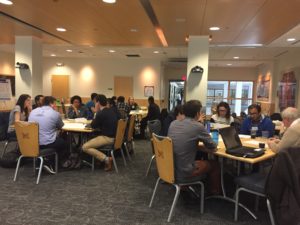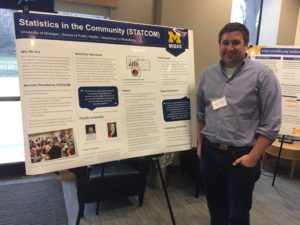
Ece Sanci, Sharanya Chandran and Emily Morris from STATCOM present on their ideas to address food scarcity in Toledo, OH (photography credit to Dave Waterhouse).
From understanding the influence of congressional members’ Twitter accounts to discussing why the global crude oil price rose again after 2016, the second annual Data for Public Good Symposium will showcase the unique ways in which students, faculty, staff and community members have analyzed and assessed data to benefit others.

Students, faculty and staff gather to discuss how their work in data has created positive social change (photography credit to Dave Waterhouse).
The conference takes place 10 a.m.-4:30 p.m. Feb. 19 at Forum Hall, Palmer Commons. Registration is free and open to the public.
“We want to showcase the work people can do with the skillsets they’ve acquired,” said Steve Salerno, U-M doctoral student in biostatistics and co-president of the student organization Statistics in the Community (STATCOM). “We tend to think of volunteering as something we do for a day, but this is a way someone can do something philanthropic for an extended period of time while using their expertise.”
The day will include networking, presentations of oral abstracts, a poster session and case study workshop. Presentation topics include:
- Partners for Preschool: The Added Value of Learning Activities at Home During the Preschool Year
- University-Community Partnership to Support Ambitious STEM Teaching: Leveraging University of Michigan expertise in education, research, and evaluation to support innovative, interactive teaching across the S.E. Michigan region and beyond
- Open Data Flint, Stage II
- Research-Practice Partnerships at the Youth Policy Lab
- The LOOP Estimator: Adjusting for Covariates in Randomized Experiments
- Barrier Busters: Unconditional Cash Transfers as a Strategy to Promote Economic Self-Sufficiency
- Implementing Trauma-Informed Care at University Libraries
- Why did the global crude oil price start to rise again after 2016?
- Poverty and economic hardship in Michigan communities: Data from the Michigan Public Policy Survey
- Understanding Networks of Influence on U.S. Congressional Members’ Public Personae on Twitter

Evan Reynolds presents on STATCOM’s work for nonprofits and community organizations (photography credit to Dave Waterhouse).
“We hope people have a better understanding of the work that’s being done on campus,” Salerno said. “People don’t realize these resources are out there and organizations like STATCOM can help.”
The idea to connect people working with data originated with STATCOM, the Community Technical Assistance Collaborative (CTAC) and Ann Arbor Data Dive, three organizations that use data to help local nonprofits and community organizations.
Members from these groups learned there were others on campus who also used data to create positive social impact and realized everyone could benefit from collaborating.
“We want to break down the silos and foster future collaborations,” said Tim NeCamp, U-M doctoral student in statistics.
STATCOM worked closely with the Center for Education Design, Evaluation, and Research; Michigan Institute for Data Science; and CTAC to make this event possible.


